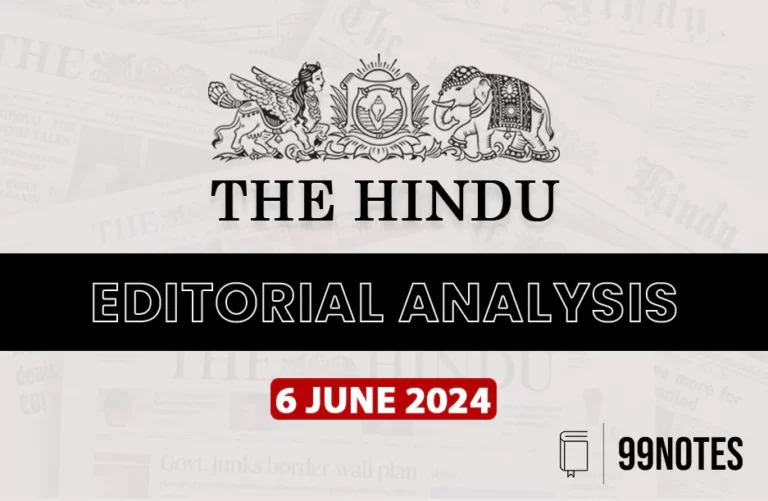INDIAN EXPRESS EDITORIAL: 05TH JUNE 2024
1. The show must go on
| Topic: GS2 – Governance – Government policies– Interventions for development in various sectors |
| Context: |
| The recent election outcome, contrary to market and exit-poll expectations, has set a new stage for the incoming government. The primary objective should be to drive a rapid increase in per capita GDP through inclusive and environmentally sustainable growth, amid a shifting global landscape moving from globalization to protectionism, with high-interest rates and receding fiscal stimuli. |
Employment and Economic Diversification:
Addressing Disguised Employment:
- One of the critical challenges is the disguised employment in the agricultural sector. The government must create adequate employment opportunities in the industrial and services sectors.
- High power and logistics costs burden manufacturing, with industrial power subsidizing agricultural power and commercial railway freight subsidizing passenger fares.
- Monetizing the increased market capitalization of public sector units (PSUs) offers an opportunity for strategic divestment to raise necessary resources.
Boosting Consumption and Inclusive Growth:
- Enhancing Bottom-Pyramid Consumption: Boosting consumption, particularly at the bottom of the pyramid and in mass-market products, can be achieved through innovative schemes like gold monetization. This would bring idle gold into the mainstream economy, increasing liquidity and providing additional resources to stimulate economic growth.
- Agricultural Sector Revitalization: Agriculture remains a cornerstone for inclusive and sustainable growth. Emulating successful cooperative models like Amul for other commodities and substituting imports with local production can create significant local opportunities. Export-focused agricultural policies and bilateral trade arrangements, such as exchanging food for oil, can further support this growth.
Trade and Labor Policies:
- Free Movement and Labor Agreements: Negotiating free labor movement with long-term work permits in Free Trade Agreements (FTAs) can enhance remittances, a significant source of income for India. This reciprocal access could boost both trade and labor markets.
- Skill Development Initiatives: Institutional mechanisms across India should be established to provide necessary skills, like the plumbing institute in Kendrapara, Odisha. Such initiatives can supply skilled labor domestically and internationally.
Industrial and Service Sector Development:
- Production-Linked Incentive (PLI) Schemes: Expanding manufacturing jobs through improved PLI schemes can transform sectors like garments, processed agro products, automobiles, auto components, engineering, lab-grown diamonds, jewelry, and shipbuilding, creating employment, especially for women.
- Service Sector Support: Tourism, education, and healthcare services must be developed through integrated approaches. The Indian diaspora can act as brand ambassadors to promote these sectors. India has the potential to offer high-quality, low-cost healthcare and world-class education, which can cater to an aging global population with underfunded healthcare systems.
Investment and Legal Frameworks:
- Unlocking Domestic Capital: Investment is crucial for growth. Unlocking savings frozen in real estate, gold, and currencies through innovative methods can ensure adequate domestic capital for entrepreneurs.
- Judicial Infrastructure Improvement: Strengthening the judicial infrastructure to reduce case pendency and resolve disputes quickly can attract more investment. Many investors prefer arbitration outside India due to current inefficiencies.
Ease of Doing Business and Technological Investment:
- Improving Business Environment: Addressing land acquisition challenges and labor laws by creating special economic zones with simplified regulatory frameworks can significantly improve the ease of doing business.
- Future Technologies Investment: Investing in future technologies through public-private partnerships, as proposed in the vote on account, can be a game-changer. Establishing institutions for artificial intelligence and integrating the pharma industry with large-scale research facilities can drive innovation.
Environmental and Sustainable Growth
- Green Growth Model: As a low per capita carbon emitter, India should pursue a green growth model through renewable energy while seeking compensation via technology and capital grants for historical emissions. Implementing carbon credit schemes and emission taxes can create a level playing field globally.
- Responsible Mining Policies: Developing responsible mining policies that balance local and industrial interests can reduce coal imports and utilize India’s vast coal reserves effectively.
Education, Healthcare, and Financial Literacy:
- Leveraging Technology for Public Services: Enhancing education and healthcare through public-private partnerships and technology can significantly improve these sectors. Direct Benefit Transfers (DBT) and education coupons can enhance the quality of education by increasing accountability and choice.
- Promoting Financial Literacy: Encouraging investor education initiatives to improve financial literacy can help Indians make better investment decisions, avoiding suboptimal allocations in cryptos, Ponzi schemes, and derivatives trading, thereby reducing poverty and enhancing economic stability.
| Practice Question: Analyze the multifaceted approach required by the incoming government to achieve rapid per capita GDP growth through inclusive and environmentally sustainable development. Discuss the key policy measures that should be prioritized. (250 words/15 m) |
(Source: Indian Express; Section: The Ideas Page; Page: 13)




